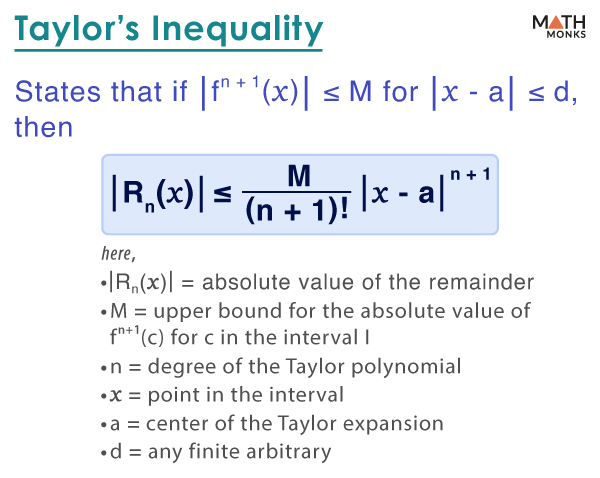Taylor’s inequality provides an estimated value for the remainder term, Rn(x), when approximating a function using a finite Taylor series that includes up to the nth term.
Statement
It states that if f(x) is (n + 1) times differentiable on the interval ‘I’ containing ‘a’ and ‘x,’ then for each x Є I, the remainder Rn(x) satisfies:
${\left| R_{n}\left( x\right) \right| \leq \dfrac{M}{\left( n+1\right) !}\left| x-a\right| ^{n+1}}$
Formula
Mathematically, the formula is written as:
If ${\left| f^{n+1}\left( x\right) \right| \leq M}$ for ${\left| x-a\right| \leq d}$, then
${\left| R_{n}\left( x\right) \right| \leq \dfrac{M}{\left( n+1\right) !}\left| x-a\right| ^{n+1}}$ for ${\left| x-a\right| \leq d}$
Here,
- ∣Rn(x)| is the absolute value of the remainder
- ‘M’ is an upper bound for the absolute value of f(n+1)(c) for c in the interval ‘I’
- ‘n’ is the degree of the Taylor polynomial used in the approximation
- ‘x’ is a point in the interval,
- ‘a’ is the center of the Taylor expansion, and
- ‘d’ is any fixed finite arbitrary.
Proof
Now, let us prove the inequality using mathematical induction on ‘n’
Base Step:
For n = 0, Taylor’s inequality formula states:
|R0(x)| ≤ M |x – a|1 …..(i)
Since |R0(x)|, the error term for the first-degree polynomial is bounded by ‘M,’ the inequality (i) holds true
Inductive Step:
Now, assuming Taylor’s inequality holds true for some integer n = k, we have
${\left| R_{k}\left( x\right) \right| \leq \dfrac{M}{\left( k+1\right) !}\left| x-a\right| ^{k+1}}$
On considering n = k + 1, we get
|R(k + 1)(x)|
By Taylor’s theorem, we get
${R_{k+1}\left( x\right) =\dfrac{f^{\left( k+2\right) }\left( c\right) }{\left( k+2\right) !}\left( x-a\right) ^{k+2}}$, for some c Є (a, x)
Since |f(k + 2)(c)| ≤ M for |x – a| ≤ d, we have
${\left| R_{k+1}\left( x\right) \right| =\left| \dfrac{f^{\left( k+2\right) }\left( c\right) }{\left( k+2\right) !}\left( x-a\right) ^{k+2}\right| \leq \dfrac{M}{\left( k+2\right) !}\left| x-a\right| ^{k+2}}$
⇒ ${\left| R_{k+1}\left( x\right) \right| \leq \dfrac{M}{\left( k+2\right) !}\left| x-a\right| ^{k+2}}$, which means Taylor’s inequality holds true for n = k + 1
Thus, Taylor’s inequality is proved for all positive integers ‘n.’
Finding ‘M’
We need to calculate the value of ‘M’ to estimate the nth-degree polynomial function and find the accuracy of the approximation.
The three ways to determine its value are discussed:
Case 1: when ‘f’ is a sine or cosine function, the derivative alternates, such as
sin → cos → -sin → -cos → sin → cos → …
These functions have |fn| ≤ 1, and thus, for the sine or cosine functions, we get M = 1 for bounding the derivative irrespective of the function’s order.
Case 2: we find the maximum value of ‘f(n + 1)’ on some interval by setting it equal to zero and finding the critical points.
Case 3: If the functions are either increasing or decreasing, they do not have any critical points on the interval, and thus, either the left or right endpoint yields the maximum value.
For example, if f(n + 1) = ${\dfrac{24}{x^{5}}}$ and the interval is [2, 7], then the function is increasing on the interval, and its maximum value is f(n + 1)(7) = ${\dfrac{24}{\left( 7\right) ^{5}}}$ ≈ 0.001428 (corrected up to 6 decimal places) at x = 7
Thus, the value of ‘M’ is anything larger than |0.001428|
Here, we observe that the (n + 1)th derivative of the function ‘f’ and the interval ‘I’ are needed to determine ‘M.’ One exception to this is mentioned above with the sine and cosine functions, where we take M = 1.
Solved Example
![]() Use Taylor’s inequality to estimate the accuracy of the approximation f(x) = ln(x) ≈ p3(x) where x Є [1, 2.5]
Use Taylor’s inequality to estimate the accuracy of the approximation f(x) = ln(x) ≈ p3(x) where x Є [1, 2.5]
Solution:
![]()
Here, f(1) = ln(1) = 0
f’(x) = ${\dfrac{1}{x}}$ ⇒ f’(1) = 1
f’’(x) = ${\dfrac{-1}{x^{2}}}$ ⇒ f’’(1) = -1
f’’’(x) = ${\dfrac{2}{x^{3}}}$ ⇒ f’’’(1) = 2
It follows that p3(x) = ${f\left( 1\right) +f’\left( 1\right) \left( x-1\right) +\dfrac{f”\left( 1\right) }{2!}\left( x-1\right) ^{2}+\dfrac{f”’\left( 1\right) }{3!}\left( x-1\right) ^{3}}$
= ${0+1\left( x-1\right) -\dfrac{1}{2!}\left( x-1\right) ^{2}+\dfrac{2}{3!}\left( x-1\right) ^{3}}$
By Taylor’s inequality formula, we get
${\left| R_{n}\left( x\right) \right| =\left| f\left( x\right) -p_{n}\left( x\right) \right| \leq \dfrac{M}{\left( n+1\right) !}\left| x-a\right| ^{n+1}}$
⇒ ${\left| R_{3}\left( x\right) \right| =\left| f\left( x\right) -p_{3}\left( x\right) \right| \leq \dfrac{M}{4!}\left| x-1\right| ^{4}}$, where ‘M’ is an upper bound for f(4)(x) on the interval [1, 2.5] …..(i)
Also, we have f(4)(x) = ${\dfrac{-6}{x^{4}}}$, which is an increasing function on [1, 2.5].
Thus, the maximum value is obtained by the left endpoint of the interval.
At x = 1, we get
M = f(4)(1) = ${\dfrac{-6}{\left( 1\right) ^{4}}}$ = -6
From (i), Taylor’s inequality formula becomes ${\left| R_{3}\left( x\right) \right| \leq \dfrac{-6}{24}\left| x-1\right| ^{4}}$
⇒ ${\left| R_{3}\left( x\right) \right| \leq \dfrac{-1}{4}\left| x-1\right| ^{4}}$
Since |x – 1| ≤ 1 for x Є [1, 2.5], we get
${\left| R_{3}\left( x\right) \right| \leq \dfrac{-6}{24}\left| x-1\right| ^{4}\leq \dfrac{-1}{4}\cdot \left( 1\right) ^{4}}$
⇒ ${\left| R_{3}\left( x\right) \right| \leq \dfrac{-1}{4}}$
Thus, the approximation is accurate to within ${\dfrac{-1}{4}}$ ≈ -0.25

